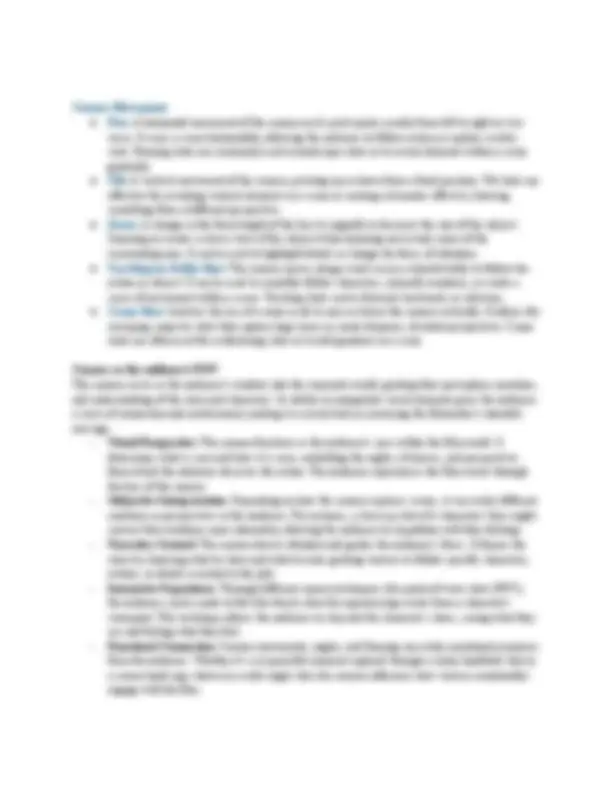



Study with the several resources on Docsity

Earn points by helping other students or get them with a premium plan


Prepare for your exams
Study with the several resources on Docsity

Earn points to download
Earn points by helping other students or get them with a premium plan
Community
Ask the community for help and clear up your study doubts
Discover the best universities in your country according to Docsity users
Free resources
Download our free guides on studying techniques, anxiety management strategies, and thesis advice from Docsity tutors
BASIC NOTES ON FILM THEORY FOR FILMMAKERS AND STUDENTS TO ENHANCE THEIR STUDIES
Typology: Study notes
1 / 3

This page cannot be seen from the preview
Don't miss anything!


What is cinematography? ● Cinematography refers to the art and technique of capturing visual images for a motion picture (film or video). It involves the creative and technical decisions related to the composition, lighting, camera movement, framing, and overall visual aesthetics of a film or video production. ● Cinematographers work closely with directors, producers, and other members of the film crew to visually interpret the screenplay or director's vision. ● In other words, cinematography involves a combination of technical expertise, artistic creativity, and collaboration to visually translate the director's vision into compelling and impactful visuals that enhance the storytelling of a film or video production. Camera Angles & Shots Camera Angles ● Camera angles refer to the position or height of the camera concerning the subject or scene being filmed. They dictate the perspective from which the audience views the action or characters. ● Examples of camera angles include eye-level, low angle, high angle, Dutch angle, and bird's-eye view. These angles influence how the audience perceives the subjects in terms of power dynamics, emotions, and visual storytelling. ➔ Types of Camera Angles & when to use them The choice of camera angle depends on the director's vision, the emotions they want to evoke, the message they want to convey, and the storytelling context of the scene. Each angle serves a purpose in influencing how the audience interprets the visual information presented in a film or video. 1) Eye-Level Shot: This angle is captured at the eye level of the subject. It's a neutral angle used in many scenes as it provides a natural and relatable perspective. It's great for dialogue scenes, normal daily activities, and when you want the audience to empathize or connect easily with the characters. 2) Low Angle Shot: This angle is taken from below the eye level of the subject, looking upward. It's often used to emphasize the power, dominance, or strength of a character or subject. It can make the subject appear larger or more imposing. Directors might use this angle to portray a hero or a person in authority. 3) High Angle Shot: This angle is taken from above the subject, looking downward. It can make the subject appear smaller, weaker, or more vulnerable. It's used to evoke feelings of inferiority, powerlessness, or to show the perspective of a higher authority or observer. It can be employed in scenes to make the audience feel superior to the character. 4) Dutch Angle (or Oblique Angle): In this shot, the camera is intentionally tilted to create a slanted or skewed frame. It's used to convey disorientation, tension, or psychological unease. Directors might use this angle in intense or suspenseful moments, dream sequences, or to portray a character's mental state. 5) Bird's Eye View: This shot is taken from directly overhead, looking down on the subject. It provides a comprehensive view of the scene and can be used to show the spatial relationships between characters and their environment. It's often employed in establishing shots or to depict a large crowd or landscape.
Camera Shots ● Camera shots, on the other hand, refer to the framing of subjects within the camera's view. They concern the distance between the camera and the subject and determine how much of the scene or subject is visible. ● Examples of camera shots include extreme long shot, long shot, medium shot, close-up, and extreme close-up. These shots help in emphasizing details, conveying emotions, and framing the action within the scene. To sum up, camera angles focus on the position and perspective of the camera in relation to the subject, while camera shots focus on the framing and distance between the camera and the subject. ➔ Types of Camera Shots & when to use them Each shot serves a specific purpose in conveying emotions, emphasizing details, and contributing to the storytelling. ● Wide Shot (WS): WS captures the subject from a great distance, showing a vast area or landscape. It's used for establishing shots to set the scene, introduce a location, or establish context before zooming in on the characters or action. ● Long Shot (LS) : This shot frames the entire body of one or more subjects within the shot. It's commonly used in action scenes or when characters' physical movements and interactions with the environment are essential to the narrative. ● Medium Shot (MS): A medium shot frames the subject from the waist up. It's versatile and often used for dialogue scenes, allowing viewers to focus on facial expressions, gestures, and interactions between characters. ● Close-Up (CU): This shot tightly frames the subject's face or a specific detail. Close-ups are used to capture emotions, convey intimacy, highlight important details, or emphasize a character's reaction or thoughts. ● Point-of-View Shot (POV): The POV shot allows the audience to see the scene from a character's perspective. It's used to immerse viewers in the character's experience, especially during moments when the character is looking at something significant or experiencing heightened emotions. ● Over-the-Shoulder Shot (OTS): This shot is taken from behind a character's shoulder, showing the perspective of another character. It's commonly used during conversations or confrontations to establish the relationship between characters and create a sense of engagement.